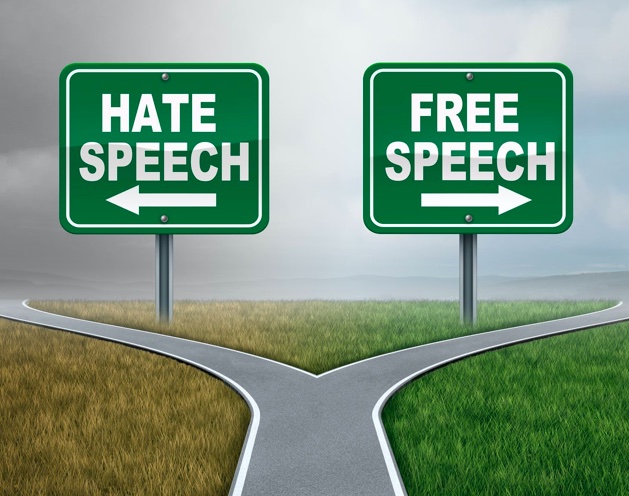The Human Rights Case against President Trump: Sanctioning Incitement to Violence
By Audrey Fino

source: shutterstock.com
The events leading to the second impeachment trial against former US President Donald Trump in February 2021 once again placed ‘hate speech’, and in particular ‘incitement to violence’, squarely in the news. President Trump was charged with ‘incitement of insurrection’ ‘by inciting violence against the Government of the United States.’ In a speech he gave during a `Save America' rally on January 6, 2021, President Trump told his audience, a crowd of fervent supporters, some carrying arms openly and known members of white supremacist groups, that `[w]e're going to walk down to the Capitol because you'll never take back our country with weakness. You have to show strength and you have to be strong’ and `we fight. We fight like hell.’ Immediately after this speech, the crowd stormed the Capitol, injured and killed people, and threatened US Congressional members.
Notwithstanding the fact that President Trump was ultimately acquitted by Congress (and in spite of the peculiar US constitutional context of impeachment), the substantive legal issues raised are of particular interest to human rights lawyers, wherever they may be. Arguably, the case against Trump, which this blog will explore, turns on whether through his speech he incited the crowd to commit violent acts, including crimes, against individuals or groups of individuals with a different political opinion from his. These would be the congressional Democrats, his political opponents, but also those he perceived to be disloyal to him, including Vice President Mike Pence, because they refused his demand not to certify the electoral college results giving the electoral victory to his political opponent, Joe Biden (collectively the ‘target group’).
At the outset it should be noted that this blog addresses a purely hypothetical legal situation. Immunity laws for heads of state will likely bar the possibility of any criminal investigation into this matter. Further, the US has not ratified Optional Protocol 1 to the International Covenant on Civil and Political Rights (ICCPR) which allows for individual complaints before the Human Rights Committee.
The facts surrounding Trump’s speech will be analysed against the necessity, including proportionality (see Human Rights Committee, General Comment 34), requirement set forth in article 19(3) of the ICCPR. An assessment of the other requirements of legality and legitimacy of purpose are beyond the scope of this blog. To aid this inquiry it is helpful to also consider the Rabat Plan of Action threshold test to assess the gravity of the incitement, as proposed by the 2020 UN Strategy and Plan of Action on Hate Speech: UN Guidance on Implementation for UN Field Presences. If all six indicators exist, the test would suggest that the speech qualifies as incitement and should be criminally sanctioned.
Here is how Trump’s speech fares against the Rabat Plan of Action test, a practical tool widely disseminated in UN circles:
The content of the speech is often the starting point of any analysis of incitement. First, the plain meaning of the words used by President Trump, though provocative and based on falsehoods, on their face do not directly amount to incitement to commit violent acts or commission of crimes. The key word ‘fight’ is often used in political discourse to fire up the base. Yet, the content of the speech, the message, was understood by his audience as a call to arms. The subsequent testimony of some of them shows that they believed to be doing his bidding when they attacked the Capitol. How the audience understands the speaker’s message is key to analysing any speech act.
The position of the speaker—to gauge what authority the speaker has over the audience—is another consideration. President Trump was not only the US President but their political leader and his supporters’ devotion to him indicates that they were likely to be influenced by his messaging.
Words do not exist in a vacuum, so the context is highly relevant in assessing speech. In the months preceding the scheduled Joint Session of Congress, President Trump repeatedly and falsely asserted that the Presidential election results were the product of widespread fraud and should not be accepted by the American people. In this context of repeated false claims, the timing of the speech, given just before the Joint Session of Congress was due to certify Biden’s electoral victory, the combative style of delivery and the location of the rally, within walking distance of the Capitol, the speech could amount to incitement to violence, even if his words are considered equivocal.
Trump’s speech was given during a much-publicized political rally and its extent was far-reaching. It was planned weeks ahead and President Trump widely encouraged his supporters to travel to Washington DC for it. As early as 19 December 2020, he tweeted: ‘Be there, will be wild!’ The use of social media before, during and after the speech disseminated it even further.
Intent to incite or provoke someone into action is required for criminal incitement. Intent can be inferred from the words and context of the speech and President Trump’s conduct, before, during and after the violent acts that took place. Of course, Trump would likely argue he was merely promoting his political agenda. Yet, the following considerations, taken cumulatively, point to his intent to incite: the repeated false assertions that the election had been stolen from him and his followers; the timing of his speech―just before the Joint Session of Congress was due to convene; his claim in the speech that ‘if you don’t fight like hell you’re not going to have a country anymore’; his inaction in the first few hours of the storming of the Capitol; his reported glee at what was going on; and his address to the crowd, later that afternoon, repeating the falsehood that ‘[w]e had an election that was stolen from us.’
Was there a likelihood, including an imminent risk of violence against the target group? There is evidence showing that elements of, amongst others, white supremacist groups, who also carried arms openly, were present in Trump’s audience that day. This was public knowledge in the media. As President, he must also have had information, including from his daily security briefings, on the potential internal threat of violence in the country. At the very least, the likelihood of imminent risk of violence must have been foreseeable to him.
Turning to President Trump’s potential counterarguments, as we have seen in the impeachment trial, Trump’s defence averred that his speech was protected as free expression. Relatedly, he could argue that he was merely giving a political speech aimed to enthuse his supporters, and that a plain reading of the words spoken shows he had not encouraged the audience to storm the Capitol nor be violent. In any case, he could make a viable argument that more latitude should be given to political figures, who through their advocacy of different viewpoints, contribute to public debate, a fundamental tenet of a democratic society.
All in all, however, I would submit that the content and extent of the speech, its context, including where and when he gave it, his authority and intent, and his knowledge or reason to know of the likelihood of imminent risk of violence, point unequivocally to incitement to violence and would likely meet the necessity requirement to sanction it under article 19(3).
Bio:

Audrey Fino is a lecturer in human rights, public international and international humanitarian law at the University of Groningen and visiting lecturer at the University of Malta. She is currently also a PhD researcher on the parameters of freedom of expression in human rights and international criminal law. She has more than twenty years of practical experience as a lawyer, amongst others, at the International Criminal Tribunal for the Former Yugoslavia, the UN Office of the High Commissioner for Human Rights, and REDRESS.